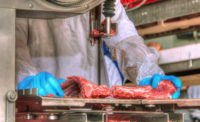Worker safety: a safe bet
Meat and poultry operators that focus on worker safety and wellness are in position to reap huge paybacks in performance and productivity.

Adjustable work stations help ease working stress on the body, as one size work station does not fit all workers. (Photo courtesy of Omaha Steaks International)

Proper safety equipment is essential when handling dry ice. (Photo courtesy of Omaha Steaks International)


Worker safety is a key elementin an effective meat and poultry processing operation. Leveraging programs that are designed to reduce injuries and illnesses enhances employee morale, boosts operating efficiencies and reduces health care costs.
To emphasize the importance of such initiatives and motivate plants and distribution centers to institute sound safety and health programs, the Washington, D.C.-based American Meat Institute (AMI) even offers annual Workers Safety Recognition Awards.
Indeed, it is essential that processors be proactive in monitoring facility situations and regularly upgrade practices as an evolving workforce is creating new safety issues. Elements include an aging employee base in which many longtime workers are no longer able to perform tasks with the same skill, agility and strength levels as in the past.
It is resulting in a greater focus on ergonomics as operators seek to reduce injuries to muscles, nerves and tendons that often result from lifting heavy items, bending, reaching overhead, pushing and pulling heavy loads, working in awkward body positions and performing the same or similar tasks repetitively.
The ergonomic answer
Land O’Frost Inc., a Lansing, Ill.-based producer of lunchmeats, sausages and franks — and recipient of an AMI safety award — has an ergonomics team at each location that studies incidents, such as back strains and repetitive stress, and uses video and other tools to determine how best to reduce occurrences.
The company, for instance, previously had employees manually fill racks with 30-pound casings of meat, requiring them to lift the items thousands of times a day. After its ergonomic team labeled the job an unacceptable risk, Land O’Frost contributed 50 percent of the funds to have a contractor design a prototype loader for the procedure.
“The device completely eliminated hazards to employees’ backs, shoulders and elbows and also increased efficiency,” says Travis Ellis, Land O’Frost corporate director of environmental health and safety and former chairman of the AMI Worker Safety and Health Committee. “The employees that run the equipment were previously manual laborers and now they are machine operators. It resulted in yield improvement and safety.”
He notes that the company, which has about 1,000 plant workers, spent well over $100,000 per workstation for the machines, which are situated in each plant.
Ergonomics is just one of the approximately 30 Land O’Frost safety programs that are internally developed and devised from Occupational Safety and Health Administration (OSHA) guidelines. In addition to classroom training at its facilities, the company also sends workers to outside classes for specialty instruction, such as on ammonia safety and boiler operations.
Land O’Frost, meanwhile, conducts training sessions in employees’ native languages and also holds English as a Second Language (ESL) classes for foreign-born workers to enhance communication.
Such education is essential if plants and distribution centers are to minimize incidents.
“There are always potential issues when there are humans, machines and equipment,” Ellis says. “We look for new ways that technology can be used to create a safe and low-risk environment. Anytime there is new equipment or production lines, there is the possibility of creating new hazards.”
And among the more hazardous environments are the wet facilities common to many meat and poultry operations. To reduce the threat of incidents at such locations, Land O’Frost conducts a floor audit at least once a year to ensure surfaces properly grip the boots and shoes of workers. Coverings on floors, platforms and stairs are replaced if they become worn, and proper footwear is provided.
Land O’Frost also emphasizes proper lockout/tagout procedures, which involve disabling machinery or equipment to prevent the release of hazardous energy — such as electricity and air — while employees perform servicing and maintenance activities.
“It is a program where you literally hold the key to your health,” Ellis says. “All employees have to know the hazards on all equipment.”
Such safety education extends outside plants to Land O’Frost’s fleet of tractor-trailer drivers. Because drivers spend minimal time at company facilities, they often receive information and training via newsletters.
Land O’Frost, however, is looking to incorporate technology that will enable drivers to receive safety training electronically in their vehicles during down time, such as when they are waiting at a loading dock.
A team effort
Developing superior safety systems also requires input from a variety of sources, notes Paul Rutledge, environmental health and safety director for Sheboygan, Wis.-based Johnsonville Sausage LLC — another recipient of the highest AMI safety award.
Johnsonville’s audit safety management system, which covers approximately 1,400 workers in six locations, incorporates national safety council standards, and was developed with contributions from AMI members, consultants and focus groups. It is upgraded annually following evaluation of practices at each site and interviews with workers.
“Getting to our goal of zero injuries is a journey with lots of learning,” Rutledge says, noting that Johnsonville injury frequency rates have fallen 74 percent since 2004. The rate, he notes, is now one-third the average of the meat industry, down from slightly above the industry average a decade ago.
A major company focus is to maintain effective procedures while keeping pace with an ever-changing facility environment, Rutledge says. To support its mission, Johnsonville recently implemented a companywide learning management system that features computer-based training for individuals and groups.
Topics presented to workers vary based on their jobs and can include industrial vehicle safety, personal protective equipment and hazardous equipment training. There are about 20 standard general-awareness classes and approximately 17 worker-specific classes with many featuring custom-designed content.
Employees are encouraged to observe the behavior of colleagues and point out unsafe practices.
Such observations often are recorded on cards or entered into databases with key findings shared with the greater workforce. Topics might include, for instance, the safest way to unjam a machine or the need to wear cut-resistant gloves.
Some safety topics may appear routine as Rutledge says a major issue is combating satisfaction and complacency at locations, particularly when incident rates are significantly below industry averages.
“We know there still is a lot to learn from others inside and outside the industry in order to achieve a zero injury rate,” he says. “That also keeps us grounded to our focus.”
Future plans include keeping the safety system “on a cutting edge” by driving knowledge and training, Rutledge says.
“The easier risks have been mitigated,” he says. “Now a concern is dealing with such elements as soft-tissue injuries and repetitive motion issues associated with the aging workforce. It is harder to change procedures as you get closer to having zero injuries, but the journey is worth it.”
Adopting a new perspective
That journey includes getting employees to constantly focus on safety. It can be difficult, however, to change mindsets if the workers previously were at locations that did not emphasize proper procedures.
“We’ve had employees tell us that they’ve gotten into trouble in the past for bringing up safety issues because their company instead stressed productivity,” says Beth Fry, director of risk management for Omaha, Neb.-based Omaha Steaks International. “So it is important to make sure they understand how seriously safety is now taken.”
Omaha Steaks, also an AMI safety award recipient, has more than 500 workers in three plants and a distribution center who are encouraged to participate in safety initiatives. Employees, for instance, have input on procedures by serving on the company’s safety and ergonomics committee.
Workers also go on safety inspections with specialists to better understand the elements that are scrutinized, and employees are eligible to receive cash awards for offering the best safety suggestions.
To ensure they have jobs that can be safely managed, workers receive pre-placement physical ability screenings by occupational nurses at sites. It includes ergonomic testing, which is intended to reveal if individuals can meet the physical demands of jobs, such as by gauging how hard they can grip equipment and boxes.
“It is important to make safety programs interactive with employees,” Fry says. “New workers, for instance, may not be used to gripping cutting knives eight hours day. Adjustments are made if an employee is sore or says they are uncomfortable at a particular work station.”
Omaha Steaks’ safety training includes sessions on hazard communication, emergency procedures, protection equipment, extreme-temperature procedures for workers who spend time in freezers and lockout/tagout methodologies.
Each plant also has a designated trainer to advise new employees, and experts visit facilities to instruct workers on specific issues. They include electrical safety authorities who reveal guarded ways to handle electrical equipment.
In addition, a power equipment program is designed to reduce incidents on forklifts and other machinery. Software-based systems installed on forklifts, for instance, monitor activity and are programmed to stop an operation and sound an alarm if a driver has an accident. Cash awards are given out on a quarterly basis to accident-free operators.
On the flipside, disciplinary action is taken against workers who don’t follow proper safety procedures, particularly for such tasks as lockout/tagout where the consequences can be severe injuries.
Fry notes that awareness training is crucial if plants are to achieve optimum safety.
“If your job requires you to lift 35 pounds on occasion, we don’t want you to try lift 55 and risk injury,” she says. “That is especially important for employees who have been with us for many years and have not taken a physical in a while. Workers are encouraged to state concerns on all safety issues to employees who serve on safety committees or to their supervisors.”
Employee safety is one of the best investments meat and poultry operators can make in the quest to maintain motivation and productivity in their facilities. While a changing worker and environment landscape necessitates a constant focus on incorporating the most pertinent safety techniques and technologies, the payback from such endeavors can be prodigious.
Looking for a reprint of this article?
From high-res PDFs to custom plaques, order your copy today!












